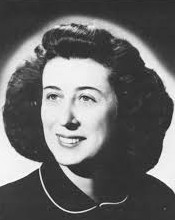Janice C. Beatley facts for kids
Quick facts for kids
Janice Carson Beatley
|
|
|---|---|

Photograph of Janice Beatley
|
|
| Born | 18 March 1919 Columbus, Ohio, United States
|
| Died | 14 November 1987 (aged 68) |
| Education | Ohio State University |
| Known for | Botanical research at NNSS |
| Scientific career | |
| Fields | Botany |
| Thesis | The primary forests of Vinton and Jackson counties, Ohio (1953) |
| Author abbrev. (botany) | Beatley |
Janice Carson Beatley (born March 18, 1919 – died November 14, 1987) was an American botanist. She was famous for studying plants in Ohio's forests. She also studied plants at the Nevada Atomic Test Site. Beatley taught Biological Sciences at the University of Cincinnati. Three types of plants are named after her, including Astragalus beatleyae.
Contents
Janice Beatley's Early Life and Schooling
Janice Carson Beatley was born in Columbus, Ohio. Her parents were Earle and Alice Beatley. She finished North High School in Columbus in 1935.
She then went to The Ohio State University. There, she earned three different degrees. In 1940, she got a Bachelor of Arts (B.A.) in zoology. Later, she earned a Master of Science (M.S.) in botany in 1948. Finally, she received her PhD in botany in 1953. Her advanced studies focused on plant ecology, which is how plants interact with their environment.
Her Amazing Career in Botany
During her early career, Beatley did a lot of research on the forests of central and southern Ohio. She studied over 1,000 different types of wintergreen herbaceous plants. These are plants that stay green all year. Her work, published in 1956, was called "The winter-green herbaceous flowering plants of Ohio." Many people believe this was the first full study of its kind in North America.
She continued to study Ohio's plant life. But in 1960, her work changed direction. She began working at the Atomic Test Site in south-central Nevada. She stayed there for 13 years. Her studies there included finding and mapping native and non-native plants. She also looked at how things like rain and radioactive dust affected the plants. Later, she returned to Ohio but kept doing research in Nevada.
Over her career, Beatley worked at several universities. These included the University of Tennessee, East Carolina College, North Carolina State University, and New Mexico Highlands University. She collected more than 10,000 plant samples. These samples are now kept in special collections called herbariums across the United States.
Research at the Nevada Test Site
From 1960 to 1973, she was a research ecologist. She worked for the University of California, Los Angeles and the Nevada Test Site in Mercury, Nevada. In 1973, she became a professor of Biological Sciences at the University of Cincinnati. She taught there until 1987. She was also a research associate at The Ohio State University's Herbarium from 1983 to 1987.
Her important work at the Nevada Test Site started in 1962. She set up 68 special study areas. At first, she planned to study how radiation affected plants. But this plan changed in 1963. That's when the United States stopped testing nuclear weapons in the air. Even so, her study sites became very important. They helped scientists record how the environment changed over time. She published reports until 1980. Much of her information was not published, but it was all given to the USGS after she passed away. Her sites were "an ideal place to conduct long-term ecosystem research."
Beatley was a member of many science groups. She also strongly supported several groups that protect the environment. Three plant species are named after her: Astragalus beatleyae, Eriogonum beatleyae, and Phacelia beatleyae.
Janice Beatley died from pneumonia on November 14, 1987. After she passed away, The Ohio State University created the Janice Carson Beatley Herbarium Fund in her honor.
Images for kids
-
Beatley buckwheat, Eriogonum rosense var. beatleyae



